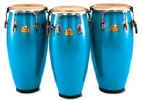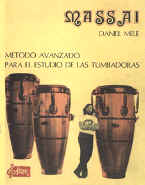| |
HISTORY

These instruments are named depending on the
region where they are used. In Central America they are called
manual drums, “congas” or “tumbadoras”, but the most popular name is
“Congas”.They have a low tone and they are used to execute more
powerful music. Besides, the rhythmical figures generally imitate a
bass phrase. There are different kind of congas, the most primitive
ones are from Africa, they are made of wood from an empty trunk
which has a leather drumhead. The leather can come from antelopes,
leopards, monkeys, giraffes or gazelles. You can stick the leather
on the trunk, tie it or pierce it using wooden nails. The sound is
emitted when you beat the leather with your hands which produces a
resonance because of the air going out through the leather extreme
of the trunk. There are two ways of playing this drums :sitting down
on the floor taking care to bend it to make the sound go out through
the bottom of the instrument or being hang on your body by a belt.
One of the most characteristic is Atumpan’s instrument which is used
by the Ashanti to send messages. In Uganda region we find the
Engalabi, Embutu and Omubala which are used in assembling of
counterpoint. Another modern kind of conga replaces the trunk by
hard wooden tables (called staves) the same that are used to make
barrels and they are put one next to the other and the leather is
stained by tacks nailed on the wood.
These types of drums are used in tribal dances from Africa, Central
America and Haiti.
The congas used by rock and roll, salsa and jazz groups nowadays,
have the same construction of those mentioned above (wooden tables)
but the leather is strained by metal tensors fixed on the conga body
at the lower extreme and on a metal ring on the top. This ring goes
round the piece of leather and it allows to change the tuning at any
moment. The leather generally comes from mules, horses or cows. Thin
leather offers better tuning and a clear sound. Fat leather offers
durability, projection and high volume. Te newest model is the one
fiberglass piece with metal tensors and he advantage is that it has
a more brilliant sound.
The measures of the congas goes from 9 to 12 inches on their top
extreme and they are generally played by two or three. The smallest
one is called quinto, the medium one is called conga and he biggest
one tumbadora.
Methodology:
I PROVIDE PC
MUSIC SOFTWARE FOR WINDOWS 64 BITS FOR RHYTHM READING WITH REAL
CONGA SOUNDS, WHICH MAKES LEARNING EASIER.
YOU CAN LEARN THE RHYTHMS BY LISTENING TO THEM AS THEY SOUND, YOU
CAN LEARN TO READ THEM BY MUSIC AND PLAY THEM AND YOU CAN PLAY
THE RHYTHMS AT THE SAME TIME AS THE SOFTWARE AND ALSO CHANGE THE
SPEED OF PLAYING.
The study of congas includes:
Advanced method of tumbadoras “Massai” by Daniel Mele.

Technique:
Brief historical introduction.
Tuning way
Position to play them
Musical terminology
Different type of beating:
open wide tone, simple low tone,
slap, palm beat, dark ring beat, ring beat, both hands roll, one
hand roll, appoggiatura, glisando and tremolo.
Musical reading
Different figures:
quintillo, double time, sixteen notes triplet,
quarter notes triplet
Meters:
odd meters: 5/8,7/8,11/8,13/8 and zorcico 10/8
Compound meters: 6/8,9/8,12/8
Different styles:
Brasilian ,salsa, candombe,guaguanco, bomba,
cumbia, mazacote, guaracha, merengue, columbia, Cuban conga,
Afrocuban, etc.
Fills for
slow tempos
Salsa
solo
Ray Barretto solo
Three congas rhythm
Paradidles method and its techniques by Daniel Mele.
Accent method by C: Wilcoxon
Scores analysis, study and reading
Rhythms to accompany recorded music.
Polyrhythms
Improvisation development
Assembling
Atabaque
touches, Umbanda and Candomblé
IJEXA
ARREMATE
NAGO
KABULA
SAMBA KABULA
KONGO DE OURO
KONGO DE KABOCLO
KONGO DE NAGO
BARRAVENTO
OLODUM
MARCAÇAO
QUEBRA-TRATO
RENDA
PUXADA DE REDE
SAO BENTO (CAPOEIRA DE ANGOLA)
MAKULELE |
|

